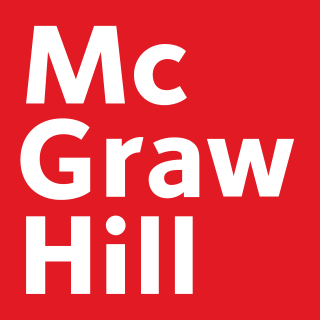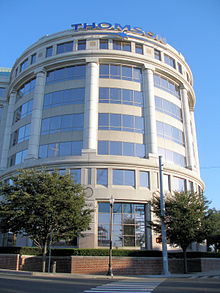
ProQuest LLC is an Ann Arbor, Michigan-based global information-content and technology company, founded in 1938 as University Microfilms by Eugene Power, a BA and MBA graduate of the University of Michigan.
Thomson Financial was an arm of the Thomson Corporation, an information provider. When the Thomson Corporation merged with Reuters to form Thomson Reuters in April 2008, Thomson Financial was merged with the business of Reuters to form the Markets Division of Thomson Reuters.

Roy Herbert Thomson, 1st Baron Thomson of Fleet, was a Canadian-born British newspaper proprietor who became one of the moguls of Fleet Street in London.

Kenneth Roy Thomson, 2nd Baron Thomson of Fleet, known in Canada as Ken Thomson, was a Canadian/British businessman and art collector. At the time of his death, he was listed by Forbes as the richest person in Canada and the ninth richest person in the world, with a net worth of approximately US $19.6 billion.

Pearson plc is a British multinational publishing and education company headquartered in London, England.
David Kenneth Roy Thomson, 3rd Baron Thomson of Fleet, is a Canadian/British hereditary peer and media magnate. Upon the death of his father in 2006, Thomson became the chairman of Thomson Corporation and also inherited his father's British title, Baron Thomson of Fleet. After the acquisition of Reuters in 2008, Thomson became the chairman of the merged entity, Thomson Reuters.
Prometric, also known as Prometric Testing, is a U.S.-based company operating in the test administration industry. The corporate headquarters are located in Baltimore, Maryland, United States. The company manages a vast network of test centers, with thousands of sites in 160 countries, where various examinations are conducted, including those for India-Common Entrance Test, North American Veterinary Licensing Examination, and Secondary School Admission Test.
Reuters Group plc was a British multinational media and financial information company headquartered in London, United Kingdom. It was acquired by the Thomson Corporation in 2008, forming Thomson Reuters, and moved its head office to Toronto.

Apax Partners LLP is a British private equity firm, headquartered in London, England. The company also operates out of six other offices in New York, Hong Kong, Mumbai, Tel Aviv, Munich and Shanghai. As of December 2017, the firm, including its various predecessors, have raised approximately $65 billion (USD) since 1981. Apax Partners is one of the oldest and largest private equity firms operating on an international basis, ranked the fifteenth largest private equity firm globally.
Reference Manager was the first commercial reference management software package sold by Thomson Reuters. It was the first commercial software of its kind, originally developed by Ernest Beutler and his son, Earl Beutler, in 1982 through their company Research Information Systems. Offered for the CP/M operating system, it was ported to DOS and then Microsoft Windows and later the Apple Macintosh. Research Information Systems was acquired by Thomson Business Information in 1994. Subsequently, Thomson acquired EndNote and ProCite, the other two leading bibliographic management programs. Rich Niles, founder of EndNote, joined Thomson Reuters as head of that division, and put all development focus on EndNote. Sales of Reference Manager continued until December 31, 2015, and support ended on December 31, 2016.
Gale is a global provider of research and digital learning resources. The company is based in Farmington Hills, Michigan, United States, west of Detroit. It has been a division of Cengage since 2007.
Thomson Scientific was one of the six strategic business units of The Thomson Corporation, beginning in 2007, after being separated from Thomson Scientific & Healthcare. Following the merger of Thomson with Reuters Group to form Thomson Reuters in 2008, it became the "Scientific" business unit of the new company. In 2009, the unit came together with the Healthcare division of Thomson Reuters to form the Healthcare & Science division. The healthcare business was sold in 2012 to become Truven Health Analytics. The Science unit of Thomson Reuters provided information services for the academic, business, and R&D communities. It had headquarters in Philadelphia, London, Singapore and Tokyo with about 2,400 staff in more than 20 countries. Its products were Aureka, Delphion, Cortellis, Derwent World Patents Index (DWPI), EndNote, Horizon Global, Horizon Sourcing, IDdb, IDRAC, IP Management Services, ISI Web of Knowledge, MicroPatent PatentWeb, Techstreet Industry Standards, ThomsonPharma, GeneGo, IDDB, Thomson Regulatory Solutions, and Web of Science.

Thomson Reuters Corporation is a Canadian multinational information conglomerate. The company was founded in Toronto, Ontario, Canada and maintains its headquarters in that city's Bay Adelaide Centre.
The Woodbridge Company Limited is a Canadian private holding company based in Toronto, Ontario. It is the primary investment vehicle for members of the family of the late Roy Thomson, 1st Baron Thomson of Fleet. David W. Binet has been the president and chief executive officer of the company since 2012.

Cengage Group is an American educational content, technology, and services company for the higher education, K–12, professional, and library markets. It operates in more than 20 countries around the world.
Mitchell International, Inc. is an American company based in San Diego, CA, which develops software used by the automotive industry to manage collision and medical claims, parts and labor estimates, and glass replacement quotes. Mitchell operates throughout the United States and Canada, and processes more than 50 million transactions a year for more than 300 insurance companies, more than 30,000 collision repair facilities, independent adjusters, and other vehicle repair participants.

McGraw Hill is an American publishing company for educational content, software, and services for pre-K through postgraduate education. It is one of the "big three" educational publishers along with Houghton Mifflin Harcourt and Pearson Education. The company also publishes reference and trade publications for medicine, business, and engineering. Formerly a division of The McGraw Hill Companies, McGraw Hill Education was divested and acquired by Apollo Global Management in March 2013 for $2.4 billion. McGraw Hill was sold in 2021 to Platinum Equity for $4.5 billion.

Tradeweb Markets Inc. (Tradeweb) is an international financial services company that builds and operates electronic over-the-counter (OTC) marketplaces for trading fixed income products, ETFs, and derivatives. The company was co-founded in 1996 by Lee Olesky and Jim Toffey. Its customers include banks, asset managers, central banks, pension funds and insurance companies.

Refinitiv is an American-British global provider of financial market data and infrastructure. The company was founded in 2018 as a subsidiary of Thomson Reuters, which then sold a 55% stake to Blackstone Group LP in August 2018. In October 2019, Blackstone and Thomson Reuters announced the sale of the company to London Stock Exchange Group. LSEG completed the US$27 billion purchase from the two previous owners in late January 2021, and Refinitiv is now a subsidiary of LSEG. The company has an annual turnover of $6 billion with more than 40,000 client companies in 190 countries.

Clarivate Plc is a British-American publicly traded analytics company that operates a collection of subscription-based services, in the areas of bibliometrics and scientometrics; business / market intelligence, and competitive profiling for pharmacy and biotech, patents, and regulatory compliance; trademark protection, and domain and brand protection. In the academy and the scientific community, Clarivate is known for being the company which calculates the impact factor, using data from its Web of Science product family, that also includes services/applications such as Publons, EndNote, EndNote Click, and ScholarOne. Its other product families are Cortellis, DRG, CPA Global, Derwent, MarkMonitor, CompuMark, and Darts-ip, and also the various ProQuest products and services.












